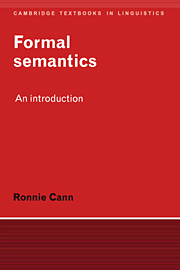Book contents
- Frontmatter
- Contents
- List of figures
- Preface
- List of symbols
- 1 INTRODUCTION
- 2 PREDICATES AND ARGUMENTS
- 3 NEGATION AND CO-ORDINATION
- 4 TYPE THEORY
- 5 THE LAMBDA OPERATOR
- 6 QUANTIFICATION
- 7 INFERENCE
- 8 TIME, TENSE AND ASPECT
- 9 POSSIBLE WORLDS
- 10 INTENSIONAL SEMANTICS
- Answers to selected exercises
- References
- Index
4 - TYPE THEORY
Published online by Cambridge University Press: 05 June 2012
- Frontmatter
- Contents
- List of figures
- Preface
- List of symbols
- 1 INTRODUCTION
- 2 PREDICATES AND ARGUMENTS
- 3 NEGATION AND CO-ORDINATION
- 4 TYPE THEORY
- 5 THE LAMBDA OPERATOR
- 6 QUANTIFICATION
- 7 INFERENCE
- 8 TIME, TENSE AND ASPECT
- 9 POSSIBLE WORLDS
- 10 INTENSIONAL SEMANTICS
- Answers to selected exercises
- References
- Index
Summary
Verb phrases and other constituents
One of the conditions of adequacy for a semantic theory set up in Chapter 1 is that it conform to the Principle of Compositionality. This principle requires the meaning of a sentence to be derived from the meaning of its parts and the way they are put together. The interpretation procedure for the grammar fragment set up in the last two chapters adheres to this principle insofar as the translations of sentences, and thereby their interpretations, are derived from the translations of their parts and the syntactic rules used to combine them. Thus, for example, the translation of the sentence Ethel kicked the student is derived from the translations of the two noun phrases Ethel and the student and the verb kicked. These are combined using the translation rule for transitive sentences to give kick'(ethel',the-student'). The truth or falsity of the resulting formula can then be directly ascertained by checking whether the ordered pair of entities denoted by the subject and object in that order is in the set of ordered pairs denoted by the predicate, kick'.
Unfortunately, in the theory of Chapters 2 and 3, compositionality is maintained only at the expense of the syntax. The ‘flat’ structure of the predicate-argument syntax of Lp and its interpretation requires a flat sentence structure in the English syntax in order to maintain a direct correspondence between syntax and translation, and thus a transparent relation between elements in the interpretation and constituents of the English sentence.
- Type
- Chapter
- Information
- Formal SemanticsAn Introduction, pp. 82 - 111Publisher: Cambridge University PressPrint publication year: 1993



